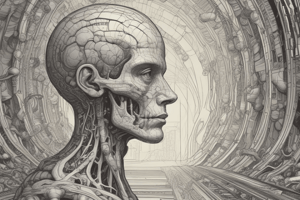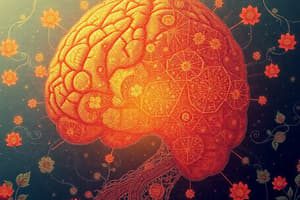Podcast
Questions and Answers
What best describes the process by which Roger perceives the street sign?
What best describes the process by which Roger perceives the street sign?
- Perception occurs independently of external stimuli.
- Perception is a combination of incoming data and existing knowledge. (correct)
- Roger's perception is based solely on incoming data from light.
- Existing knowledge and expectations play no role in perception.
Which term refers to the initial reception of stimuli by the senses?
Which term refers to the initial reception of stimuli by the senses?
- Top-down processing
- Bottom-up processing (correct)
- Transduction
- Misperception
In the case of perception, what role does 'transduction' play?
In the case of perception, what role does 'transduction' play?
- It creates a perception based solely on prior experiences.
- It transforms electrical signals into light patterns.
- It converts environmental stimuli into electrical signals for the brain. (correct)
- It eliminates incoming data that contradicts existing knowledge.
What does the 'rat-man' demonstration illustrate in terms of perception?
What does the 'rat-man' demonstration illustrate in terms of perception?
Which of the following can lead to misperception?
Which of the following can lead to misperception?
What is the principle of 'good continuation' in perceptual organization?
What is the principle of 'good continuation' in perceptual organization?
What does bottom-up processing rely on?
What does bottom-up processing rely on?
Which option best describes the principle of proximity in perceptual organization?
Which option best describes the principle of proximity in perceptual organization?
How does the principle of 'common fate' affect perception?
How does the principle of 'common fate' affect perception?
How does top-down processing affect perception?
How does top-down processing affect perception?
What does the principle of familiarity imply about perception?
What does the principle of familiarity imply about perception?
What is the significance of the experiment conducted by Stephen Palmer in 1975?
What is the significance of the experiment conducted by Stephen Palmer in 1975?
Which of the following is NOT a principle of perceptual organization?
Which of the following is NOT a principle of perceptual organization?
What does the phrase 'We see only what we know' imply about perception?
What does the phrase 'We see only what we know' imply about perception?
Why might different groups provide different answers when interpreting visual stimuli?
Why might different groups provide different answers when interpreting visual stimuli?
What is the primary function of the Gestalt approach in speech perception?
What is the primary function of the Gestalt approach in speech perception?
What does speech segmentation refer to?
What does speech segmentation refer to?
Which statement most accurately describes heuristics in problem-solving?
Which statement most accurately describes heuristics in problem-solving?
What distinguishes an algorithm from a heuristic?
What distinguishes an algorithm from a heuristic?
Which of the following best exemplifies speech segmentation?
Which of the following best exemplifies speech segmentation?
Flashcards
Perception
Perception
The process of organizing and interpreting sensory information, influenced by both incoming data and existing knowledge.
Bottom-up processing
Bottom-up processing
Perception based on the sensory information itself.
Top-down processing
Top-down processing
Perception influenced by pre-existing knowledge and expectations.
Transduction
Transduction
Signup and view all the flashcards
Misperception
Misperception
Signup and view all the flashcards
Good Continuation
Good Continuation
Signup and view all the flashcards
Proximity
Proximity
Signup and view all the flashcards
Common Fate
Common Fate
Signup and view all the flashcards
Similarity
Similarity
Signup and view all the flashcards
Familiarity
Familiarity
Signup and view all the flashcards
Context effect
Context effect
Signup and view all the flashcards
Palmer (1975) Experiment
Palmer (1975) Experiment
Signup and view all the flashcards
Object-recognition speed
Object-recognition speed
Signup and view all the flashcards
Speech Segmentation
Speech Segmentation
Signup and view all the flashcards
Gestalt Principles in Speech
Gestalt Principles in Speech
Signup and view all the flashcards
Heuristic
Heuristic
Signup and view all the flashcards
Algorithm
Algorithm
Signup and view all the flashcards
Problem Solving Approach
Problem Solving Approach
Signup and view all the flashcards
Study Notes
Visual Perception
- Perception is the conscious experience resulting from stimulation of the senses.
- Perception involves bottom-up and top-down processing.
- Bottom-up processing is data-driven, relying on incoming sensory data to form a perception.
- Top-down processing is knowledge-driven, using existing knowledge and expectations to influence perception.
Bottom-Up Processing
- Bottom-up processing analyzes objects into features, including:
- Feature Integration Theory (FIT) – features combined to form objects.
- Recognition-by-Components (RBC) theory – objects composed of geons (3D shapes).
Top-Down Processing
- Top-down processing involves Gestalt principles, which describe how the mind groups visual patterns into objects:
- Law of Pragnanz (good figure, simplicity): The mind perceives figures in the simplest, most symmetrical form possible.
- Law of Similarity: Similar elements are grouped together.
- Law of Good Continuation: Connected points tend to form straight or smooth lines.
- Law of Proximity: Elements that are close together are grouped together.
- Law of Common Fate: Elements moving in the same direction are grouped together.
- Law of Familiarity: Things are grouped if they form a familiar or meaningful pattern.
- Law of Closure: Gaps in figures are filled in to create a complete form.
- Law of Figure/Ground: An element is perceived as separate from its background
- Perception is influenced by context and existing knowledge. Knowledge plays a major role in perception, as existing knowledge influences how we interpret the sensory data we receive.
Misperception
- Misperception occurs when there is a mismatch between the stimulus and the perception, leading to an incorrect interpretation of the sensory data.
Intelligent Activity in Perception
- Perception is an intelligent activity, which is complex and not simply a passive reception of sensory information.
- Humans use heuristics (shortcuts) and algorithms (detailed procedures) to solve problems of perception.
- Heuristics provide quick, but not always accurate, solutions.
- Algorithms provide guaranteed solutions but can be time-consuming.
Experience-Dependent Plasticity
- Our brains have learned to prioritize certain stimuli, such as faces, due to evolutionary or environmental experiences.
- Experience influences the development of neurons which is an example of experience-dependent plasticity.
- Areas of the brain involved in specific types of perception, like the FFA for faces, can be trained and refined through experience and environmental stimuli.
Studying That Suits You
Use AI to generate personalized quizzes and flashcards to suit your learning preferences.




